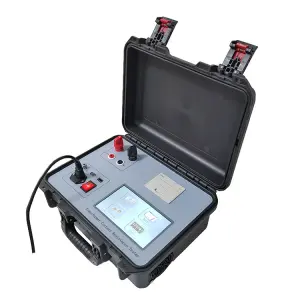Contact resistance testers find applications across various industries where ensuring proper electrical connections and minimal resistance in electrical contacts is crucial. Some typical industries and applications include:
- Power Generation and Utilities: Contact resistance testing is essential in power plants, including nuclear, thermal, or hydroelectric facilities. It’s used to assess the integrity of high-current connections in switchgear, circuit breakers, transformers, and busbars.
- Electric Utilities and Grids: Testing contact resistance in electrical substations, distribution panels, and transmission lines helps maintain reliable power distribution networks.
- Aerospace and Defense: Contact resistance testing is critical in aerospace and defense applications, ensuring the reliability of electrical connections in aircraft, satellites, radar systems, and military equipment.
- Railways and Transportation: Railway networks utilize contact resistance testers to evaluate connections in railway signaling systems, track circuits, overhead lines, and traction power systems, ensuring safety and reliability.
- Manufacturing and Industrial Settings: Contact resistance testers are employed in various manufacturing environments, Contact resistance tester including automotive, steel, chemical, and other heavy industries, to assess electrical connections in machinery, motors, and control systems.
- Telecommunications: In telecommunications, contact resistance testing verifies the integrity of connections in data centers, telecom towers, and communication systems to ensure uninterrupted data transmission and network reliability.
- Renewable Energy: Contact resistance testing is crucial in solar and wind power installations to evaluate the electrical connections in inverters, power converters, and energy storage systems.
- Maritime and Offshore Industry: Contact resistance testers are used in maritime and offshore applications to assess electrical connections in shipboard systems, offshore platforms, and marine equipment.
- Medical Equipment: In the medical field, contact resistance testing ensures reliable connections in medical devices, diagnostic equipment, and hospital electrical systems.
- Research and Development: Laboratories and R&D facilities utilize contact resistance testers in electrical research, testing prototypes, and evaluating new electrical components or materials.
The primary objective across these diverse industries is to maintain electrical reliability, prevent overheating, ensure safety, and optimize the performance of electrical connections by keeping contact resistance within specified limits.
What safety features are incorporated into the Contact resistance tester’s design?
Contact resistance testers typically incorporate various safety features to ensure operator and equipment safety during testing. Some common safety features include:
- Overvoltage Protection: Built-in mechanisms prevent excessive voltage spikes or overvoltage conditions, protecting both the device under test and the tester from damage due to voltage surges.
- Current Limiting: The tester has provisions to limit the current flowing through the device under test, preventing excessive currents that could damage the contacts or components.
- Short Circuit Protection: Safeguards against short circuits by interrupting the test current or voltage when a short circuit is detected, preventing damage to the tester or the equipment being tested.
- Isolation and Grounding: Proper isolation between the tester and the device under test, along with grounding provisions, ensures that unintended current paths are avoided, reducing the risk of electric shocks or hazards.
- Warning Indicators: Visual and audible indicators alert operators to unsafe conditions, such as voltage surges, high currents, or fault conditions during testing.
- Safety Interlocks: Interlock systems prevent the tester from operating if safety covers are open or if test connections are incorrect, ensuring that the device is used correctly and minimizing operator errors.
- Automatic Discharge: Some testers feature automatic discharge functions to discharge residual voltage across the device under test after testing, preventing unexpected shocks to operators.
- Calibration and Maintenance Alarms: Alarms or indicators alert users when the tester requires calibration or maintenance, ensuring its continued accuracy and reliability.
- Robust Enclosures: Testers are housed in durable and electrically insulated enclosures to prevent accidental contact with live components and provide physical protection against environmental factors.
- Compliance with Safety Standards: Contact resistance testers are designed and manufactured in compliance with relevant safety standards (e.g., IEC, UL, or specific industry standards), ensuring adherence to safety guidelines.
These safety features aim to minimize the risk of electrical hazards, equipment damage, and injuries to operators, ensuring that contact resistance testing is conducted safely and accurately. Users should always follow manufacturer instructions, safety guidelines, and best practices to mitigate risks during testing operations.


Leave a Reply